Philip II of Macedon › Minoan Art » Ancient origins
Articles and Definitions › Contents
- Philip II of Macedon › Who Was
- Minoan Art › Antique Origins
Ancient civilizations › Historical and archaeological sites
Philip II of Macedon › Who Was
Definition and Origins
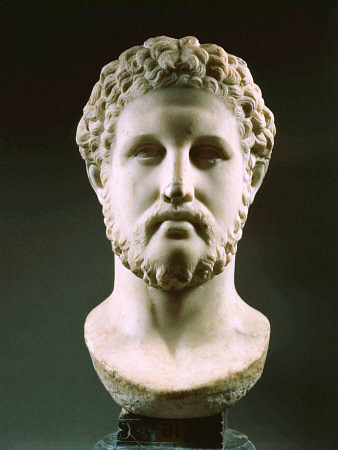
Although he is often only remembered for being the father of Alexander the Great, Philip II of Macedon (reigned 359 BCE - 336 BCE) was an accomplished king and military commander in his own right, setting the stage for his son's victory over Darius III and the conquest of Persia. Philip inherited a weak, backward country with an ineffective, undisciplined army and molded them into a formidable, efficient military force, eventually subduing the territories around Macedonia as well as subjugating most of Greece. He used bribery, warfare, and threats to secure his kingdom. However, without his insight and determination, history would never have heard of Alexander.
Unlike many of the city -states in Greece, Macedonia was a monarchy, seen as primitive and backward by the rest of Greece.Although the people spoke a Greek dialect, many believed the country was useful only as a source of timber and pastureland.The royal family of this barbaric land was the Argeads who traced their roots to both the isle of Argos and Heracles ( Hercules), the son of Zeus. Born around 383 BCE, Philip was the youngest of the three sons of Amyntas III. His older brother Perdiccas III was killed while fighting the Illyrians along the northern Macedonian border. Since the oldest Argead brother, Alexander II, was also dead, Philip was made regent for his nephew Amyntas IV. Philip assumed the Macedonian throne for himself at the age of 23 in 359 BCE. His immediate concern was twofold: to safeguard Macedonia's borders and reorganize the army. His major foes were the Illyrians (whom he would eventually defeat in 359 BCE) and the Athenians. who not only possessed nearby gold and silver mines but also supported a pretender to the Macedonian throne. Luckily, since much of Greece was embroiled in a series of civil wars, Philip had time to address Macedonia's most pressing concern.
WITHOUT PHILIP'S INSIGHT AND DETERMINATION, HISTORY WOULD NEVER HAVE HEARD OF ALEXANDER THE GREAT.
Philip quickly realized the weaknesses of his country's army and drew upon past experience to mold them into a superb fighting unit. For three years, beginning around 367 BCE, he had been a hostage in Thebes - his brother Perdiccas eventually gained his release - where he witnessed the infamous Sacred Band and the extremely successful Theban wedge, as well as the tactical abilities of their famed commanders Epaminondas and Pelopidas. Using these experiences, he completely reorganized Macedonia's army. He increased its size from 10,000 to 24,000 and enlarged the cavalry from 600 to 3,500. This was no longer an army of citizen-warriors but one of professional soldiers. He created a corps of engineers to develop siege weaponry, namely towers and catapults. To give each man a sense of unity and solidarity, he provided uniforms and required an oath of allegiance to the king: each soldier would no longer be loyal to a particular town or province but faithful only to the king. Next, he restructured the traditional Greek phalanx, providing each individual unit with its own commander, thereby allowing for better communication. Philip changed the principal weaponry from the hoplite spear to the sarissa, an 18 to 20 feet pike; it had the advantage of reaching over the much shorter spears of the opposition. Besides the sarissa, a new helmet, and a redesigned shield, each man possessed a smaller double-edge sword, or xiphos, for close-in-hand fighting.
After his reorganization of the army, he remade the capital city of Pella, inviting poets, writers, and philosophers; Aristotlewould be asked to teach Philip's son Alexander. Again, his reasoning was sound: to assure that his neighbors would not attack, he invited their sons to Pella to not only be educated but also to serve as hostages. In order to safeguard his authority at home, he established the Royal Pages to secure the throne against possible plots. However, his primary concern remained the safety and security of Macedonia. In 357 BCE he angered the citizens of Athens when he captured their colony at Amphipolis, thereby acquiring its gold and silver mines. He would temporarily return it to the city-state only to recapture it later. From there, he seized the northern Greek cities of Potedia and Pydna in 356 BCE.
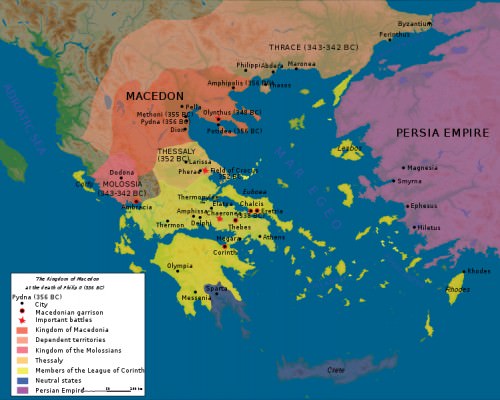
Macedonia under Philip II
Philip's power would come to fruition when he became involved in the Third Social War in 356 BCE. The Phocians had seized the city of Delphi, home of the famed oracle. Both Athens and Sparta entered the conflict on the side of the Phocians. The Thessalian League asked Philip to help and, although he was initially defeated, he and the Thessalian cavalry crushed the Phocians and their commander Onomarchus at the Battle of Crocus Field in 352 BCE. Although unable to secure alliances against Philip, Athens would continue to wage war until the Peace of Philocrates in 346 BCE. This constant warfare further weakened southern Greece. During this time, Philip expanded his hold on Greece by capturing the cities of Crenides in 355 BCE, a city he renamed Philippi ; Methone in 354 BCE which he razed; and Olynthus on the Chalcidice peninsula in 348 BCE. But he did not escape these battles without some personal scars - a lost eye, a broken shoulder, and a crippled leg.
Throughout Philip's rise to power and his victories throughout Greece, a constant thorn in his side was Demosthenes, the great Athenian orator, who constantly railed against Philip in a series of speeches called The Philippics. His fiery speeches - he would later call Alexander a brat - eventually culminated in the Battle of Chaeronea in 338 BCE, a battle that demonstrated both the power and authority of Macedonia. Philip and his son Alexander (only 18 at the time) soundly defeated the combined forces of both Athens and Thebes. Eventually, a PanHellenic Congress was summoned at Corinth (Sparta would not attend) and peace was finally established. With his establishment as the head of the Congress and his promise to secure the Greek colonies in Ionia, Philip began to plan for his invasion of Persia.
During his conquest of Greece, Philip took time away from the battlefield to marry seven times. The most famous of these marriages was to Olympias, daughter of Neoptolemus of Epirus and mother of the future conqueror of Persia, Alexander (there was also a daughter named Cleopatra ). At the time of Alexander's birth in 356 BCE, Philip was away in battle at Potidea. The historian Plutarch in his Life of Alexander wrote of this time, “Just after Philip had taken Potidea, he received three messages at one time, that Parmenio had overthrown the Illyrians in a great battle, that his race-horse had won the course at the Olympic Games, and that his wife had given birth to Alexander ….” However, as Alexander grew and his intelligence became obvious, tension rose between father and son. Because Alexander's mother was from neighboring Epirus, the king was pressured to marry a true Macedonian and provide the country with a pure-blood heir.
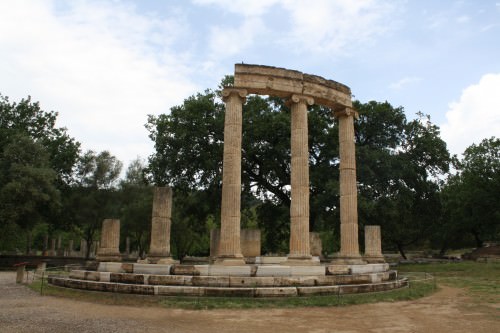
The Philippeion of Olympia
In 337 BCE Attalus, a close friend and Macedonian commander, convinced Philip to marry his niece, Cleopatra Eurydice, and provide a more suitable heir. Plutarch wrote, “At the wedding of Cleopatra, whom Philip fell in love with and married, she being much too young for him, her uncle Attalus in his drink desired the Macedonians would implore the gods to give them a lawful successor to the kingdom by his niece.” At the wedding banquet, Alexander became incensed at this idea and voiced his outrage, both at Attalus's comments and his father's drunkenness. Because of his remarks, he and his mother were both temporarily exiled - she in Epirus and he in Illyria. Shortly after his return to Pella, Alexander would be sitting on the throne.
In 336 BCE a former friend and lover of Philip, Pausanias, became angry with Philip over a personal matter and stabbed him to death. Alexander was quickly crowned as the king. Plutarch wrote, “… Pausanias, having had an outrage done to him at the instance of Attalus and Cleopatra, when he found he could get no reparation for his disgrace at Philip's hands, watched his opportunity and murdered him. The guilt of which fact was laid for the most part upon Olympias, who was said to have encouraged and exasperated the enraged youth to revenge …” Olympias' supposed part in the assassination has never been proven; however, it was widely known that she had always wanted the throne for Alexander. Philip's new wife and child were quickly put to death by Olympias, eliminating any significant claimant to the throne. After subduing any serious threats to his rule, Alexander fulfilled his father's dream and invaded Persia.
Minoan Art › Antique Origins
Definition and Origins
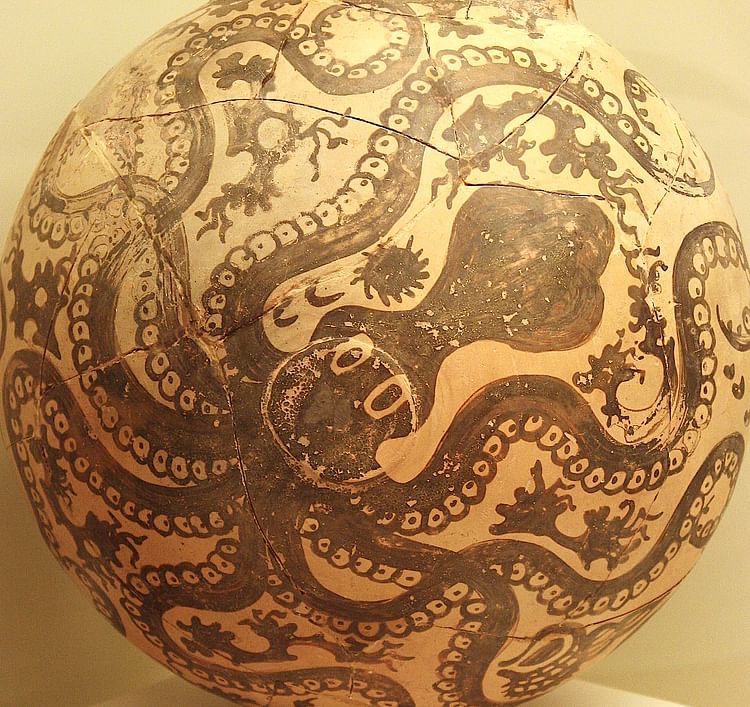
The art of the Minoan civilization of Bronze Age Crete (2000-1500 BCE) displays a love of animal, sea, and plant life, which was used to decorate frescoes and pottery and also inspired forms in jewellery, stone vessels, and sculpture. Minoan artists delighted in flowing, naturalistic shapes and designs, and there is a vibrancy in Minoan art which was not present in the contemporary East. Aside from its aesthetic qualities, Minoan art also gives valuable insight into the religious, communal, and funeral practices of one of the earliest cultures of the ancient Mediterranean.
INSPIRATIONS
The Minoans, as a seafaring culture, were in contact with foreign peoples throughout the Aegean, as is evidenced by the Near East, Babylonian, and Egyptian influences in their early art but also in trade, notably the exchange of pottery and foodstuffs such as oil and wine in return for precious objects and materials such as copper from Cyprus and ivory from Egypt. Thus Minoan artists were constantly exposed to both new ideas and materials which they could use in their own unique art.
THE MINOANS, AS A SEAFARING CULTURE, WERE IN CONTACT WITH FOREIGN PEOPLES THROUGHOUT THE AEGEAN.
Minoan art was not only functional and decorative but could also have a political purpose, especially the wall paintings of palaces where rulers were depicted in their religious function, which reinforced their role as the head of the community. It is also important to remember that art objects were largely reserved for the ruling elite, who were in the considerable minority when compared to the rest of the population who were mostly farmers. Thus, costly art works became a means to emphasise differences in social and political status for those fortunate enough to own them.
MINOAN POTTERY
Minoan pottery went through various stages of development, and the first were the pre-palatial style known as Vasiliki with surfaces decorated in mottled red and black and Barbotine wares with decorative excrescences added to the surface. Next came polychrome Kamares ware. Probably originating from Phaistos and dating from the Old Palace period (2000 BCE - 1700 BCE), its introduction was contemporary with the arrival of the pottery wheel in Crete. The distinctive elements of Kamares pottery are lively red and white designs on a black background. Geometric forms are common but there are also impressionistic fish and polyps as well as abstract human figures. Sometimes, shells and flowers were also added to the vessel in relief. Common forms are beaked jugs, cups, pyxides (small boxes), chalices, and pithoi (very large handmade vases, sometimes over 1.7 m high and used for food storage).
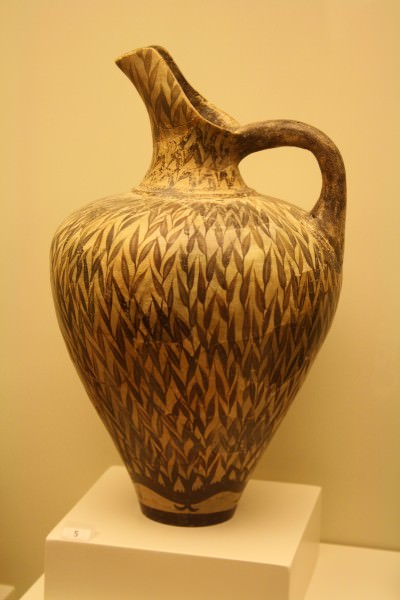
Minoan Jug in Floral Style
The New Palace period (c. 1600 BC to 1450 BCE) saw an evolution in technique and, with it, developments in both form and design, including the production of terracotta sarcophagi. More slender vases, tapering at the base became common, and new designs appeared such as the stirrup jar with one real opening and a second false one with two handles. Spirals and lines are now restricted to areas around handles and necks with, instead, plants and marine life taking centre stage. The Floral Style most commonly depicts slender branches with leaves and papyrus flowers. Perhaps the most celebrated example of this style is the jug from Phaistos which is entirely covered with grass decoration.
The contemporary Marine Style, meanwhile, is characterised by detailed, naturalistic depictions of octopuses, argonauts, starfish, triton shells, sponges, coral, rocks and seaweed. Further, the Minoans took full advantage of the fluidity of these sea creatures to fill and surround the curved surfaces of their pottery. Bull's heads, double axes, and sacral knots also frequently appeared on pottery, too.
The New Palace Style arrives from 1450 BCE. Perhaps influenced by increasing contact with the Mycenaean culture from the Greek mainland, typical examples are the three-handled amphorae, squat alabastron vessels, goblets and ritual vessels with figure-of-eight handles. Wares are decorated with much more schematic and stylised representations than the previous styles, with new designs not seen before including birds, warriors, and shields.
MINOAN STONE VESSELS
Besides terracotta, the Minoans also made vessels from a wide variety of stone types, laboriously carving the material out using chisels, hammers, saws, drills and blades. The vessels were finished by grinding with an abrasive such as sand or emery imported from Naxos in the Cyclades. Most designs were inspired by contemporary pottery shapes and even pottery decoration such as the Marine Style was transferred to stone vessels.
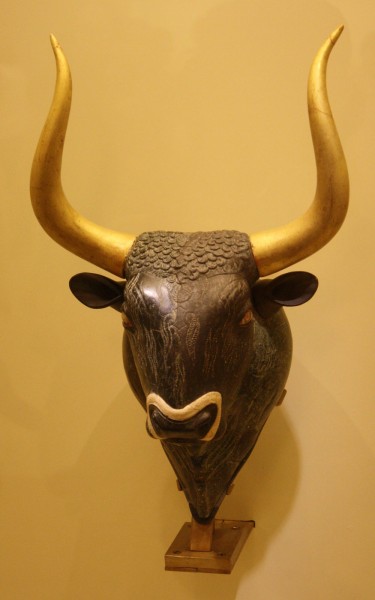
Minoan Rhyton
Popular shapes in stone include the 'bird's nest' lidded bowl which tapered significantly at the base and was probably used to store thick oils and ointments. As artists grew in confidence other, more ambitious and larger, vessels were made such as ritual vases or rhyta which could take many forms and which were usually covered in gold leaf. Perhaps the most famous example is the serpentine bull's head from the Little Palace at Knossos (c. 1600-1500 BCE) which is now in the Archaeological Museum of Heraklion. With gilded wooden horns, rock crystal eyes and a white tridacna shell muzzle the animal is superbly rendered, capturing a life-like pose that would not be equalled in art until Classical Greek sculpture a millennium later.
AN IVORY LEAPING FIGURINE IS PERHAPS THE EARLIEST KNOWN ATTEMPT IN SCULPTURE TO CAPTURE FREE MOVEMENT IN SPACE.
MINOAN SCULPTURE
Figure sculpture is a rare find in the archaeology of Crete but enough small figurines survive to illustrate that Minoan artists were as capable of capturing movement and grace in three dimensions as they were in other art forms. Early figurines in clay are less accomplished but show the dress of the time with men (coloured red) wearing belted loin cloths and women (coloured white) in long flowing dresses and open-fronted jackets. There are also bronze figurines, typically of worshippers but also of animals, especially oxen.
Later works are more sophisticated and amongst the most significant is a figurine in ivory of a man leaping in the air (over a bull which is a separate figure). The hair would have been added using bronze wire and the clothes in gold leaf. Dating to 1600-1500 BCE, it is perhaps the earliest known attempt in sculpture to capture free movement in space. Another representative piece is the striking figure of a goddess brandishing a snake in each of her raised hands. Rendered in faience, the figurine dates to around 1600 BCE. Her bare breasts represent her role as a fertility goddess, and the snakes and cat on her head are symbols of her dominion over wild nature. Both figures are in the Archaeological Museum of Heraklion, Crete.
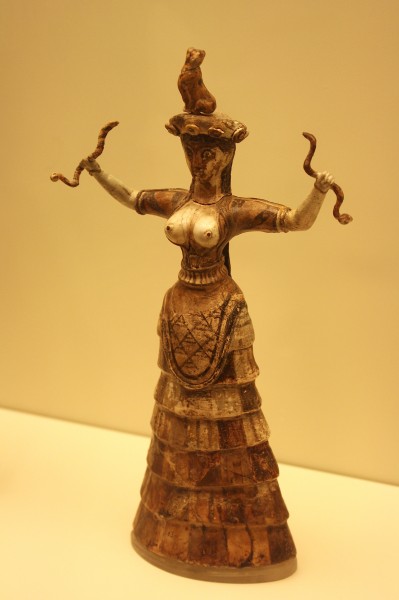
Minoan Snake Goddess, Knossos.
MINOAN FRESCOES
The Minoans decorated their palaces with true fresco painting ( buon fresco ), that is, the painting of colour pigments on wet lime plaster without a binding agent so that when the paint is absorbed by the plaster it is fixed and protected from fading.Fresco secco, which is the application of paint, in particular for details, onto a dry plaster was also used throughout the palaces as was the use of low relief in the plaster to give a shallow three-dimensional effect. Colours employed were black, red, white, yellow, blue, and green. There are no surviving examples of shading effects in Minoan frescoes, although, interestingly, sometimes the colour of the background changes whilst the foreground subjects remain unchanged. Although the Egyptians did not use true fresco, some of the colour conventions of their architectural painting were adopted by the Minoans.Male skin is usually red, female is white, and for metals: gold is yellow, silver is blue, and bronze is red.
Frescoes decorated the walls (either in their entirety or above windows and doors or below the dado), ceilings, wooden beams, and sometimes floors of the palace complexes. They depicted first abstract shapes and geometric designs, and then, later, all manner of subjects ranging in scale from miniature to larger-than-life size. Scenes of rituals, processions, festivals, ceremonies, and bull sports were most popular. Once again scenes from nature were common, especially of lilies, irises, crocuses, roses, and also plants such as ivy and reeds. Indeed, the Minoans were one of the earliest cultures to paint natural landscapes without any humans present in the scene; such was their admiration of nature. Animals, too, were often depicted in their natural habitat, for example, monkeys, birds, dolphins, and fish. Although Minoan frescoes were often framed with decorative borders of geometric designs the principal fresco itself, on occasion, went beyond conventional boundaries such as corners and covered several walls, surrounding the viewer.

Griffin Fresco, Knossos, Crete
Celebrated examples of Minoan frescoes include two young boxers, young men carrying rhytons in a procession, a group of male and female figures leaping over a bull, a large-scale seated griffin against a bold red background, and dolphins swimming above a sea floor of urchins. These can be seen at the National Archaeological Museum of Athens, the Archaeological Museum of Heraklion, and in situ (reproductions) at Knossos, Crete.
MINOAN JEWELLERY
Smelting technology in ancient Crete allowed for the refining of precious metals such as gold, silver, bronze, and gold-plated bronze. Semi-precious stones were used such as rock crystal, carnelian, garnet, lapis lazuli, obsidian, and red, green, and yellow jasper. Amethyst was also popular and was imported from Egypt where it was no longer fashionable in jewellery, a fact which illustrates the Minoan independence of mind regarding materials and design. Faience, enamel, steatite (soapstone), ivory, shell, glass-paste, and blue frit or Egyptian blue (a synthetic intermediate between faience and glass) were also at the disposal of Minoan jewellers.
Minoan jewellers possessed the full repertoire of metalworking techniques (except enamelling) which transformed precious raw material into a staggering array of objects and designs. The majority of pieces were constructed by hand, but such items as rings were often made using three-piece moulds and the lost-wax technique. Beads were sometimes made that way, too, allowing a certain mass production of these items.
Gold was the most prized material and was beaten, engraved, embossed, moulded, and punched, sometimes with stamps.Other techniques included dot repoussé, filigree (fine gold wire), inlaying, gold leaf covering and finally, granulation, where tiny spheres of gold were attached to the main piece using a mixture of glue and copper salt which, when heated, transformed into pure copper, soldering the two pieces together.
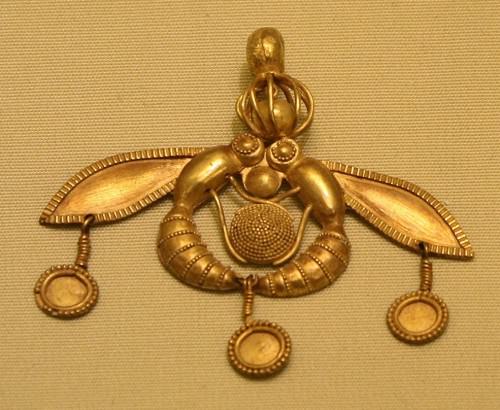
Minoan Bee Pendant
Jewellery took the form of diadems, necklaces, bracelets, beads, pendants, armlets, headbands, clothes ornaments, hair pins and hair ornaments, pectorals, chains, rings, and earrings. Rings deserve special mention as they were not only decorative but also used in an administrative capacity as seals. The majority consisted of a slightly convex oval gold bezel at a right angle to a plain hoop, also of gold. Ring bezels were most often engraved with detailed miniature scenes representing hunting, fighting, bull-leaping, goddesses, mythological creatures, and flora and fauna. These miniature masterpieces, like frescoes and pottery decoration, illustrate the Minoan fondness for filling the entire available surface even if figures had to be distorted in order to be accommodated. Another field of the Cretan jeweller and engraver was decorated weapons such as sword blades, hilts and pommels engraved with figures.
Two of the finest Minoan jewellery pieces are pendants, one of a pair of bees and the other showing a figure holding birds. The former was found at Malia and is in the form of two bees (possibly also wasps or hornets) rendered in great detail and realism, clutching between them a drop of honey which they are about to deposit into a circular, granulated honeycomb. Above the bees is a spherical filigree cage enclosing a solid sphere, and below the pendant hang three cut-out circular disks decorated with filigree and granulation. The second pendant, commonly known as the Master of the Animals pendant, is from Aegina, although research has shown it to be of Cretan origin and most probably looted in the Mycenaean period. The pendant consists of what appears to be a nature god or priest holding the neck of a water bird or goose in each hand and dressed in typical Minoan costume - belt, loincloth, and frontal sheath. Five disks hang from the base of the pendant.
LEGACY
Minoan artists greatly influenced the art of other Mediterranean islands, notably Rhodes and the Cyclades, especially Thera.Minoan artists were themselves employed in Egypt and the Levant to beautify the palaces of rulers there. The Minoans also heavily influenced the art of the subsequent Mycenaean civilization based on mainland Greece. Mycenaean potters, jewellers, and fresco painters, in particular, copied Minoan techniques, forms, and designs, although they did make their marine life, for example, much more abstract, and their art, in general, included many more martial and hunting themes.

Minoan Gold Ring
As for later times in Archaic and Classical Greece, the influence of Minoan and then Mycenaean art is difficult to trace with concrete examples. The later Greeks were certainly aware of the heritage of their forefathers in the Aegean; tholos tombs and the citadel of Mycenae were never buried from sight, for example. Depictions of double axes (or l abrys ) in stone and fresco may have combined to give birth to the legend of Theseus and the labyrinth -dwelling Minotaur so popular in classical Greek mythology. The lasting legacy of the Minoans, though, is best described here by the art historian R. Higgins:
Perhaps the greatest contribution of the Bronze Age to Classical Greece was something less tangible; but quite possibly inherited: an attitude of mind which could borrow the formal and hieratic arts of the East and transform them into something spontaneous and cheerful; a divine discontent which led the Greek ever to develop and improve his inheritance. (Higgins, 190)
LICENSE:
Article based on information obtained from these sources:with permission from the Website Ancient History Encyclopedia
Content is available under License Creative Commons: Attribution-NonCommercial-ShareAlike 3.0 Unported. CC-BY-NC-SA License